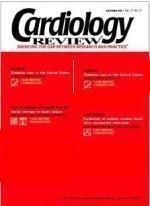Publication
Article
Cardiology Review® Online
Fixed-dose combination useful in difficult-to-treat hypertensive patients
NEW YORK CITY—Fixed-dose combination therapy can help achieve blood pressure goals in difficult-to-treat populations with hypertension, said researchers at the 19th Annual Scientific Meeting of the American Society of Hypertension.
In one study of 265 African American patients with type 2 diabetes and hypertension, the fixed-dose combination of amlodipine/
benazepril (5/10 mg daily) was compared with enalapril monotherapy (10 mg daily). At baseline, the patients were 22/16 mm Hg away from their goal blood pressure of less than 130/80 mm Hg. Patients who did not reach their target blood pressure after 4 weeks had their dosages titrated to 5/20 mg daily of amlodipine/benazepril or 20 mg daily of enalapril. Patients still not at goal at 8 weeks could have hydrochlorothiazide, 12.5 mg per day, added to their regimen.
The mean time to treatment success was significantly shorter among patients receiving the combination therapy versus monotherapy (10.1 versus 10.5 weeks, P = .012). The cumulative percentage of patients who achieved goal blood pressure was 60% in the amlodipine/benazepril group compared with 44% of the enalapril recipients (P = .008), reported lead author John M. Flack, MD, MPH, professor and associate chairman for academic affairs and chief quality officer, department of medicine, Wayne State University School of Medicine, Detroit.
The rate of diuretic use was equal in both treatment groups (approximately 75%). The adverse event profile was similar in each group, with headache being slightly more common with enalapril monotherapy and cough slightly more common with combination therapy.
“African Americans with diabetes represent one of the toughest groups to treat in terms of getting to goal blood pressures,” said Dr. Flack. “We showed that you’re better off starting with two medications than with a single pill, even when you add diuretic therapy relatively early on.”
Initial combination therapy was also shown to be superior to monotherapy in achieving blood pressure goal in older patients with systolic hypertension, reported Joel M. Neutel, MD, director of research, Orange County Research Center, Orange, California. Amlodipine/
benazepril (5/20 mg daily) was compared with each of its components separately in 443 patients at least 55 years old with a mean daytime systolic blood pressure (SBP) of 150 to 200 mm Hg and a mean diastolic blood pressure of 60 to 100 mm Hg on ambulatory blood pressure monitoring.
At week 8, amlodipine/benazepril reduced the mean 24-hour SBP
by 21.1 mm Hg compared with
12.4 mm Hg in the amlodipine monotherapy recipients (P < .001) and 10.8 mm Hg in the benazepril monotherapy recipients (P < .001), said Dr. Neutel.
Of the patients treated with amlodipine/benazepril, 65% achieved a daytime SBP of 140 mm Hg or less, compared with 28.1% and 33.8% on amlodipine or benazepril monotherapy, respectively (P < .001).
“There was less peripheral edema with combination therapy compared with amlodipine itself,” said Dr. Neutel. “You can aggressively treat patients with a combination containing complementary antihypertensive drugs without compromising safety.”
He noted that patients treated with the combination also achieved their goal blood pressure more quickly than those on single agents. Data from recent clinical trials show that patients who get to goal more quickly are less likely to have adverse cardiovascular events. The rapidity of blood pressure control also affects compliance with the regimen, he said.
